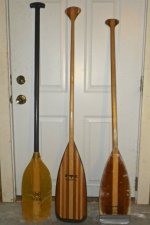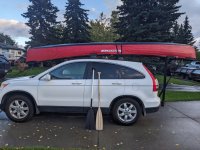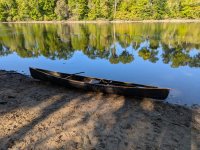Yixak, welcome to site membership! Feel free to ask any questions and to post messages, photos and videos, and to start threads, in our many forums. Please read
Welcome to CanoeTripping and Site Rules! Many of the site's technical features are explained in
Features: Help and How-To Running Thread. We look forward to your participation in our canoe community.
If you're a novice, your paddling technique of course will need lots of experimentation, practice and experience. There are many forward stroke correction techniques, which can be combined in eventually instinctive ways. You can correct at the plant and initial pull (C stroke), during the pull (pitch stroke), at the end of the pull (J stroke), and/or during the recovery (Canadian stroke). No one really knows what you are doing unless they can observe you. Seek instruction from a canoe club, ACA instructor or any experienced canoe paddler you can find.
I found my strokes getting stuck more frequently where I'd have to just pull the paddle out any way I could because when I tried to stroke normally the paddle would catch a bunch of water and just stop.
I'm not sure what you mean by the paddle getting stuck, catching water and just stopping. At the end of the pull and J correction, you should be smoothly slicing your paddle blade out of the water.
Eventually, I was able to J stroke again by making the thumb-down move more crisply and then knifing the paddle blade straight up from the rudder position.
That sounds like an improvement, but you really shouldn't be slicing the paddle edge straight up. To clarify, let's make up some terminology about the two paddle edges. When you are pulling the forward stroke, the edge facing toward the hull I'll call the "inside edge", and the edge facing away from the hull I'll call the "outside edge". It sounds as if you are J twisting your grip hand thumb down so far that the inside edge is facing 90° upward, dragging that rudder way behind you, and then slicing the
inside edge straight up out of the water.
Try it a different way. Don't bring the paddle too far behind your hip. When it's somewhat behind your hip begin the J twist of your grip hand, but don't twist the blade 90° fully vertical. Then pry away from the hull and slice the
outside edge simultaneously forward and upward at a sharp angle so the
outside edge exits the water. That that quick pry and forward/upward angled slice will provide the J correction. If you reduce the pry force and instead make slicing angle shallower, so the forward/upward slice stays in the water longer and hence exits the water further forward, that's the Canadian stroke. To repeat: for both the J and Canadian strokes, it is the
outside edge that should slice out of the water.
I know all those words are hard to visualize. Here's a decent video that briefly shows the thumb-up goon stroke, thumb-down J and Canadian strokes, and thumb-down/palm-rolled Indian stroke:
The new paddle (the silver & black one) is longer. . . . and it's collapsible
By collapsible, do you mean the length can be changed? Whatever, a paddle that is the wrong size may make it difficult to execute the various forward correction strokes efficiently. There are lots of discussions on this site and the internet generally re how to correctly size a paddle. My preference for a straight shaft paddle in flat water is to have the grip be about at my chin level when the blade is fully immersed. Longer for whitewater. Shorter for a bent shaft paddle.




